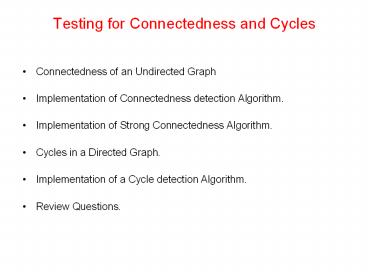Testing for Connectedness and Cycles - PowerPoint PPT Presentation
Title:
Testing for Connectedness and Cycles
Description:
Testing for Connectedness and Cycles Connectedness of an Undirected Graph Implementation of Connectedness detection Algorithm. Implementation of Strong Connectedness ... – PowerPoint PPT presentation
Number of Views:34
Avg rating:3.0/5.0
Title: Testing for Connectedness and Cycles
1
Testing for Connectedness and Cycles
- Connectedness of an Undirected Graph
- Implementation of Connectedness detection
Algorithm. - Implementation of Strong Connectedness Algorithm.
- Cycles in a Directed Graph.
- Implementation of a Cycle detection Algorithm.
- Review Questions.
2
Connectedness of an Undirected Graph
- An undirected graph G (V, E) is connected if
there is a path between every pair of vertices. - Although the figure below appears to be two
graphs, it is actually a single graph. - Clearly, G is not connected. e.g. no path between
A and D. - G consists of two unconnected parts, each of
which is a connected sub-graph --- connected
components.
3
Implementation of Connectedness Algorithm
- A simple way to test for connectedness in an
undirected graph is to use either depth-first or
breadth-first traversal - Only if all the
vertices are visited is the graph connected. The
algorithm uses the following visitor
public class CountingVisitor extends
AbstractVisitor protected int count
public int getCount() return count public
void visit(Object obj) count
- Using the CountingVisitor, the isConnected method
is implemented as follows
public boolean isConnected() CountingVisitor
visitor new CountingVisitor() Iterator i
getVertices() Vertex start (Vertex)
i.next() breadthFirstTraversal(visitor,
start) return visitor.getCount()
numberOfVertices
4
Connectedness of a Directed Graph
- A directed graph G (V, E) is strongly connected
if there is a directed path between every pair of
vertices. - Is the directed graph below connected?
- G is not strongly connected. No path between any
of the vertices in D, E, F - However, G is weakly connected since the
underlying undirected graph is connected.
5
Implementation of Strong Connectedness Algorithm
- A simple way to test for strong connectedness is
to use V traversals - The graph is strongly
connected if all the vertices are visited in each
traversal.
public boolean isStronglyConnected() if
(!this.isDirected()) throw new
InvalidOperationException(
"Invalid for Undirected Graph") Iterator it
getVertices() while(it.hasNext())
CountingVisitor visitor new CountingVisitor()
breadthFirstTraversal(visitor, (Vertex)
it.next()) if(visitor.getCount() !
numberOfVertices) return false
return true
- Implementation of weak connectedness is done in
the Lab.
6
Cycles in a Directed Graph
- An easy way to detect the presence of cycles in a
directed graph is to attempt a topological order
traversal. - This algorithm visits all the vertices of a
directed graph if the graph has no cycles. - In the following graph, after A is visited and
removed, all the remaining vertices have
in-degree of one. - Thus, a topological order traversal cannot
complete. This is because of the presence of the
cycle B, C, D, B.
public boolean isCyclic() CountingVisitor
visitor new CountingVisitor()
topologicalOrderTraversal(visitor) return
visitor.getCount() ! numberOfVertices
7
Review Questions
- 1. Every tree is a directed, acyclic graph
(DAG), but there exist DAGs that are not trees. - a) How can we tell whether a given DAG is a
tree? - b) Devise an algorithm to test whether a given
DAG is a tree. - 2. Consider an acyclic, connected, undirected
graph G that has n vertices. How many edges does
G have? - 3. In general, an undirected graph contains
one or more connected components. - a) Devise an algorithm that counts the number
of connected components in a graph. - b) Devise an algorithm that labels the vertices
of a graph in such a way that all the vertices in
a given connected component get the same label
and vertices in different connected components
get different labels. - 4. Devise an algorithm that takes as input a
graph, and a pair of vertices, v and w, and
determines whether w is reachable from v.































